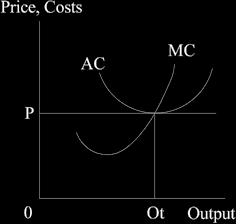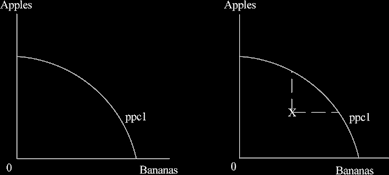| Home | Revision | A-Level | Economics | Why Markets Can Fail | What does market failure mean? |
What does market failure mean?
As we learned in previous unit, in a perfect world the price mechanism can give us a perfect allocation of resources: what is demanded is produced, changes in demand lead to changes in what is produced, and the workers move from a dying industry to a growing one.
But the world is not perfect! Some things stop us getting to this beautiful market solution. It only needs one of these particular elements to be operative, and we will fail to reach the perfect market solution above!
And in fact most of them are frequently operative in the real world in which we live! So we know that free markets do not give a perfect answer. However, we have yet to find a better way to get what we want produced: running the whole economy by central planning gives even worse results. So, poor as they may be, free markets are still the best way we have found for organising the economy. So almost all countries use the market system, then whenever as a society we do not like a particular result that they give, the government can step in and change it.
Listing these 8 major factors:
o Monopoly elements or market dominance.
o Externalities.
o Public goods.
o Merit goods.
o De-merit goods.
o Information failures.
o Factor immobility.
o Undesirable income and wealth distribution.
Unit Two deals with such imperfections and reasons for market failure. We will go through them in the order just listed.
Q. What can we do if some or all of these are operating and preventing a good market result?
A. The government can intervene and put it right.
NB These Units are a way of organising the teaching and learning of economics. You can use knowledge from one unit when answering a question in another unit – and you
should!
What does market failure mean?
It means that we do not have full efficiency; we could produce more with the resources we have; and we could satisfy consumer demands better with the resources we have. There is waste in the system.
Types of efficiency in economics:
A.) Allocative efficiency. This means good resource allocation, when we cannot make any consumer better off without making some other consumer worse off.
This approach looks at the given resources and tries to get the most output from them
– and it also means that firms sell at a fair price to consumers that reflects the real resource use.
B.) Productive efficiency. This means that production is done at the lowest possible cost.
• We are at the bottom of the average cost curve (which is always U-shaped). In that position we have what is called “X-efficiency”.
• And this means we are also on the production frontier, not somewhere inside it.
A.) Allocative efficiency
Allocative efficiency occurs when the value the consumer puts on a good or services is the same as the cost of the resources used in producing it. This occurs when price
= marginal cost! In this position, total economic welfare is maximised.
In the perfect competition diagram below, where MC = MR for the firm, we have allocative efficiency because the firm’s price is the marginal revenue (it can sell any amount at the unchanged price - each extra unit sold at that price provides the marginal revenue), so MC = P. In fact, at that point we have more equalities MC = P
= MR = AR.
“AR” is merely another word for price – it is “average revenue” which we get by dividing total revenue by quantity. We know that quantity multiplied by price gives us total revenue, so it follows that price actually is average revenue.

B.) Productive efficiency
This exists when we are actually on the production frontier. That means we are using the least resources we can. In turn, it says that we are at minimum average costs = the bottom of the AC curve.
Perfect competition is like this – so economists prefer this position and you will recall that it is known as “X-efficiency” – it is where we are totally efficient.
Where market equilibrium is totally efficient, we cannot make someone better off without making someone else worse off (this is sometimes called “the Pareto optimum position”).
The production possibility curve:
When we are below the production possibility curve (e.g., at “X” in the diagram below), we can move north-east and get onto the curve, thus making everyone better off; only when we are on it do we have proper productive efficiency.
And only when we are on it does the concept of opportunity cost arise. If we are below it, we do not have to give anything up to get more of the other thing; we can have more of both simply by moving out to the curve.

Note: we can have allocative efficiency and productive efficiency but still have
inequity in the country, which can also stop us reaching “perfection”.
Example 1. If you personally have all the income in your suburb, the other residents will be poor and might even starve, which does not sound at all like perfect! The market system is amoral i.e., it is not concerned with good or bad. Economics is not about ethics.
Example 2. Drug dealers could wait at the gates of primary schools, give away drugs for free to six year old children and in this way build up a market as they become addicted. This would create a demand, which the drug dealers could then supply later
– at a price. Most people would regard this situation as totally wrong, exploitative, and immoral – but the market would be working - and possibly very “efficiently” too.
Social efficiency matter not just private!
We might produce too much or too little as a society, for our own good, even if have perfect competition and an acceptable distribution of income and nothing illegal or immoral is occurring. This can happen because of externalities. We move on to consider these next.
NB The whole of Unit Two consists of two main components:
1. What is efficiency, why the market mechanism (price mechanism) provides the best solution for allocating resources to meet consumer demand, (Unit 1 is how it does this, with some overlap on why it is best). You need to be able to defend this proposition.
2. What prevents the market mechanism from achieving this perfection, which is the core of this whole unit. You also need to know and answer questions about how this prevents the achievement of perfection – hence you need to understand what efficiency is! We turn to consider in detail the things that stop the price mechanism working perfectly next.